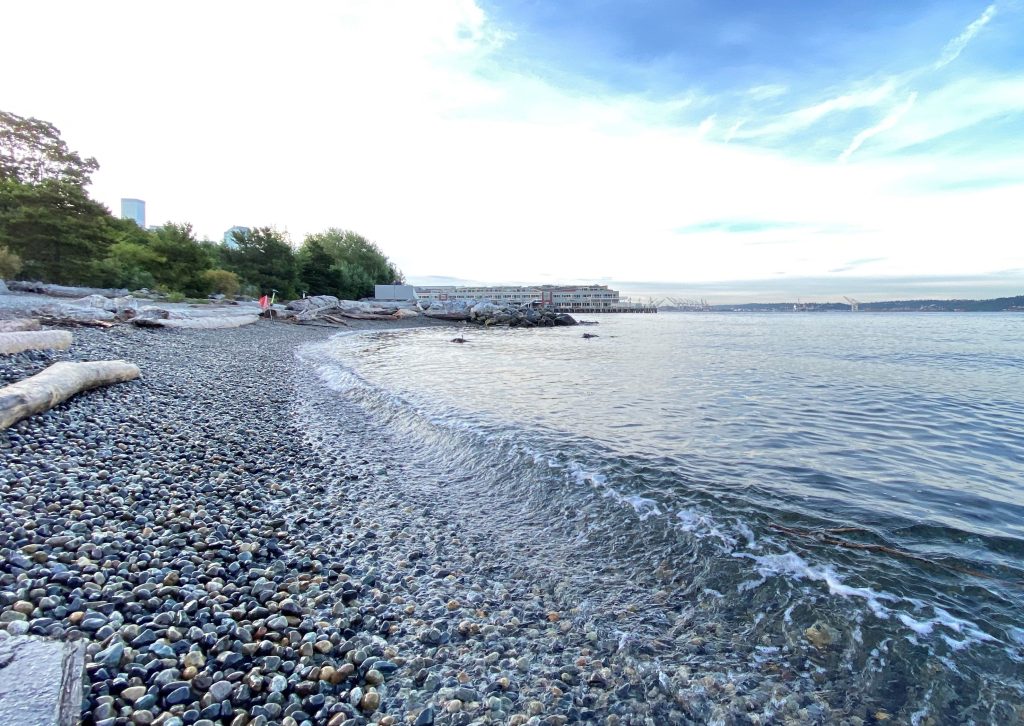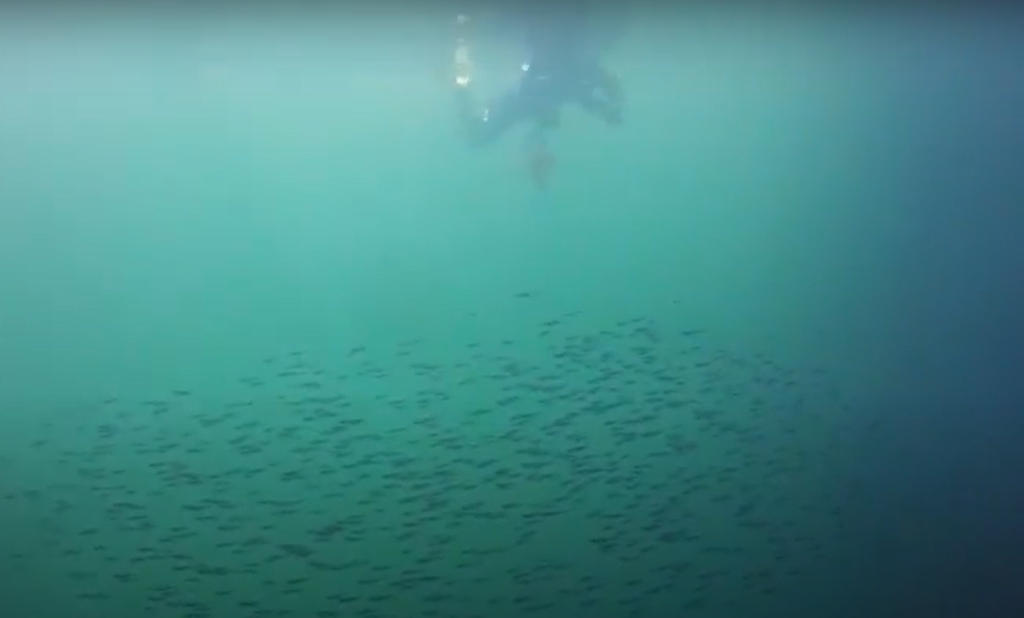SHORELINE MODIFICATIONS, like armoring and pier placement, can alter beach slope, substrate, water depth, shading, vegetation, and species (including fish) groupings and behaviors (Toft et al. 2007).
Juvenile salmon feed less and are encountered less under piers, and armoring can reduce their access to shallow water habitat. Piers can interrupt seaward migration as young salmon wait for low tides, when more light penetrates beneath, to pass under piers (Munsch et al. 2014). Shoreline modifications impact densities and richness of salmon prey (Cordell et al. 2017a), causing them to switch prey (Munch et al. 2015).


SHORELINE ENHANCEMENT Removing shoreline structures and restoring habitats can improve ecological function and habitat for juvenile fishes. In Seattle, removing shoreline armoring, constructing a subtidal bench where armor removal was impossible, and creating a shallow pocket beach increased juvenile fish densities and feeding behaviors (Toft et al. 2013). Epibenthic invertebrate densities (salmon prey) and taxa richness also increased at the two sites (Cordell et al. 2017b).
ECO-ENGINEERED SEATTLE SEAWALL The seawall and piers along half of the Seattle waterfront have been enhanced with eco-engineering. Three changes to the original seawall include
An overhead glass-block sidewalk (GB) to increase light to the water below to aid visually oriented juvenile salmon migration and feeding, and increase primary and secondary production, a raised intertidal habitat bench, (“marine mattress” – MM) to create a shallow water corridor for young salmon and substrate for epibenthic invertebrates (salmon prey), and a textured seawall with shelves (TS) to increase invertebrate colonization. In combination, these enhancements created an intertidal corridor, also known as the ‘salmon highway‘.

HAS IT WORKED? We found that the eco-engineered seawall increased habitat value for juvenile salmon by increased under-pier light, feeding, and more homogenous distribution in nearshore pier habitats with eco-engineered enhancements (Sawyer et al. 2020). Using acoustics, salmon distributions were compared between restored sites (Toft et al. 2013), eco-engineered seawall sites, and original seawall sites. Juvenile salmon are 31 times less likely to be present under original pier habitats, and 11 less likely under eco-engineered habitats than in open habitats (Accola et al. 2022). High salmon densities along pier ends early in the year show many young salmon are avoiding pier habitats and swimming around the entirety of the pier, with unknown predation and bioenergetic costs.



Salmon prey
Epibenthic invertebrate densities and taxa richness increased along the eco-engineered seawall
relative to before enhancement and are similar to what was found at the nearby Olympic Sculpture Park’s pocket beach and habitat bench. Densities of epibenthic taxa that are common prey of juvenile salmon also increased, suggesting a potential benefit to juvenile salmon.
However, juvenile chum salmon continue to feed on neritic (shallow water) plankton rather than the epibenthic invertebrates produced on the eco-engineering. We attribute this to shading by the overhead glass-block sidewalk which may drive juvenile salmon away from the eco-engineering and the source of epibenthic prey (Sawyer et al 2020).

Salmon at night
With the exception of non-eco-engineered, under-pier habitats, juvenile salmon seawall presence and densities are twice as high at night compared to day. Increased nocturnal migration and an attraction to the artificial light along the urban waterfront may contribute to day/night differences.
Juvenile salmon use the eco-engineered corridor more at night compared to day, but are infrequently found in traditional under-pier habitats. The are found more frequently along pier ends that have no shoreline eco-engineering, likely because they are avoiding the dark, under-pier habitats.

Annual Reports
Select publications
Accola KL, Horne JK, Cordell JR, Toft JD (2022) Nocturnal distributions of juvenile Pacific salmon along an eco-engineered marine shoreline. Mar Ecol Prog Ser 687:113-123. https://doi.org/10.3354/meps14006
Accola KL, Horne JK, Cordell JR, Toft JD (2022) Acoustic characterization of juvenile Pacific salmon distributions along an eco-engineered seawall. Mar Ecol Prog Ser 682:207-220. https://doi.org/10.3354/meps13917
Sawyer AC, Toft JD, Cordell JR (2020) Seawall as salmon habitat: Eco-engineering improves the distribution and foraging of juvenile Pacific salmon. Ecol. Eng. 151:105856. DOI: https://doi.org/10.1016/j.ecoleng.2020.105856
Cordell JR, Munsch SH, Shelton M and JD Toft (2017a) Effects of piers on assemblage composition, abundance, and taxa richness of small epibenthic invertebrates. Hydrobiologia 802 211-220 DOI 10.1007/s10750-017-3262-8
Cordell JR, Toft JD, Munsch SH and M Goff (2017b) Benches, beaches, and bumps: how habitat monitoring and experimental science can inform urban seawall design, in Living Shorelines: The Science and Management of Nature-Based Coastal Protection (pp. 419 – 436). CRC Press.
Munsch, SH, JR Cordell, JD Toft (2017) Effects of shoreline armoring and overwater structures on coastal and estuarine fish: opportunities for habitat improvement. Journal of Applied Ecology. DOI: 10.1111/1365-2664.12906
Munsch, SH, JR Cordell, JD Toft (2015) Effects of seawall armoring on juvenile Pacific salmon diets in an urban estuarine embayment. Marine Ecology Progress Series 535:213–229.
Munsch, SH, JR Cordell, JD Toft, E Morgan (2014) Effects of Seawalls and Piers on Fish Assemblages and Juvenile Salmon Feeding Behavior, North American Journal of Fisheries Management, 34:4, 814- 827, DOI: 10.1080/02755947.2014.910579.
Toft JD, Ogston AS, Heerhartz SM, Cordell JR, Flemer EE (2013) Ecological response and physical stability of habitat enhancements along an urban armored shoreline. Ecological Engineering 57:97–108.
Toft JD, Cordell JR, Simenstad CA, Stamatiou LA (2007) Fish distribution, abundance, and behavior along city shoreline types in Puget Sound. North American Journal of Fisheries Management 27:465–480.10.1007/s10750-017-3262-82017s
